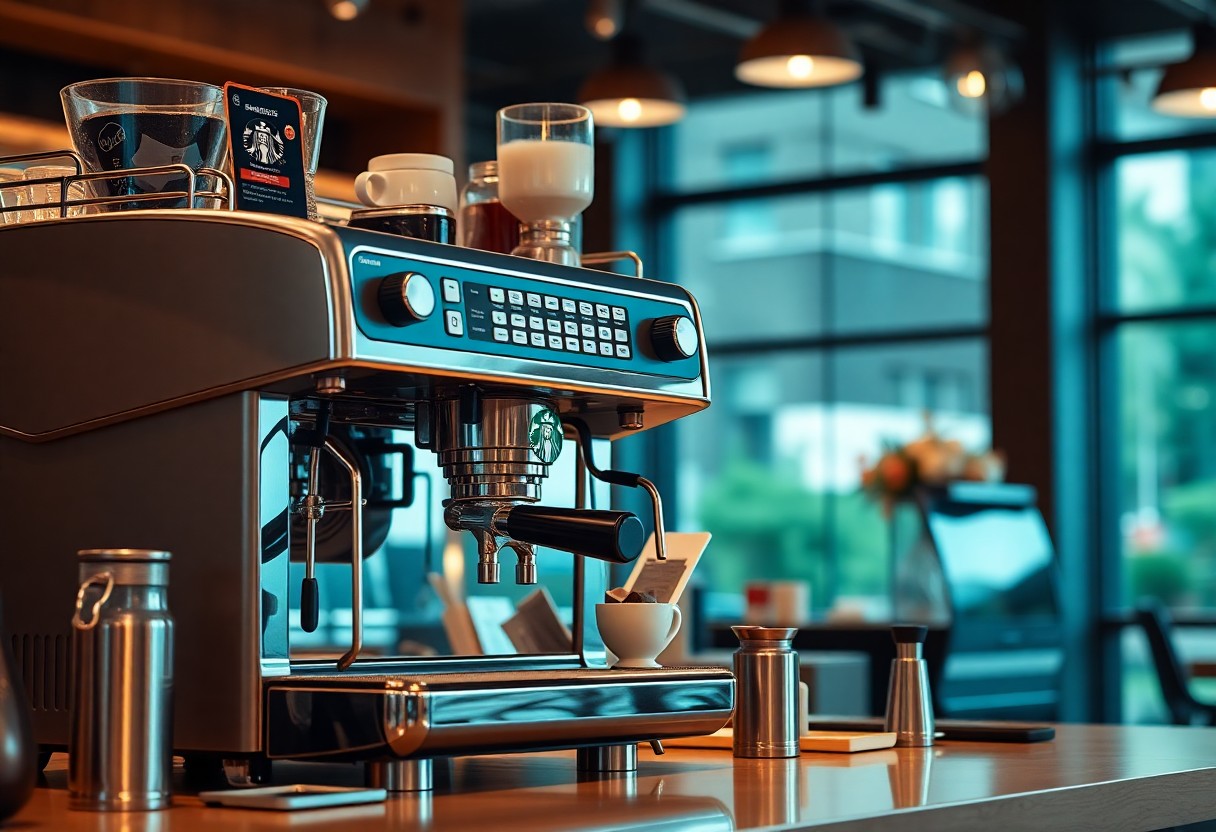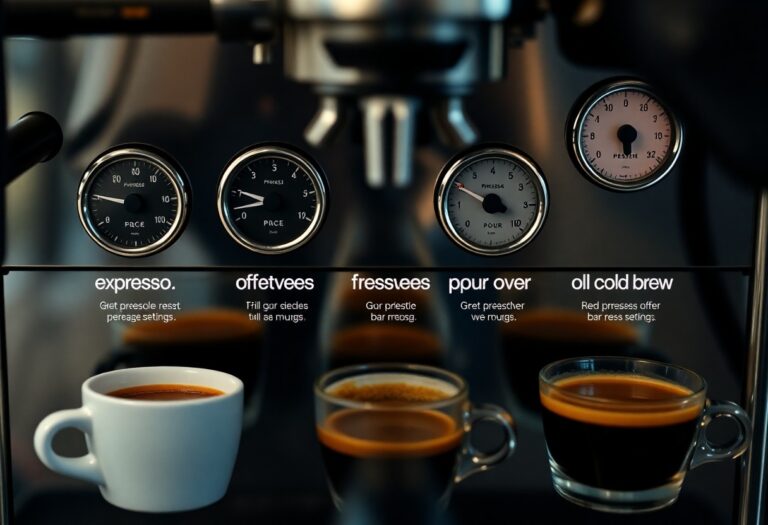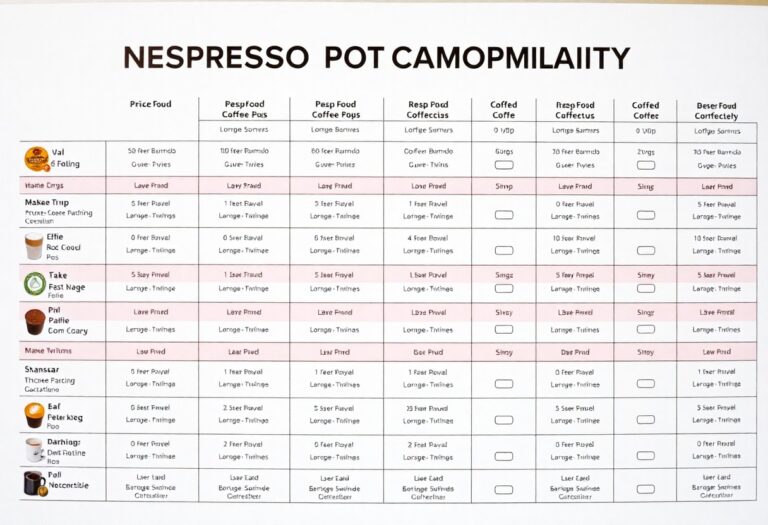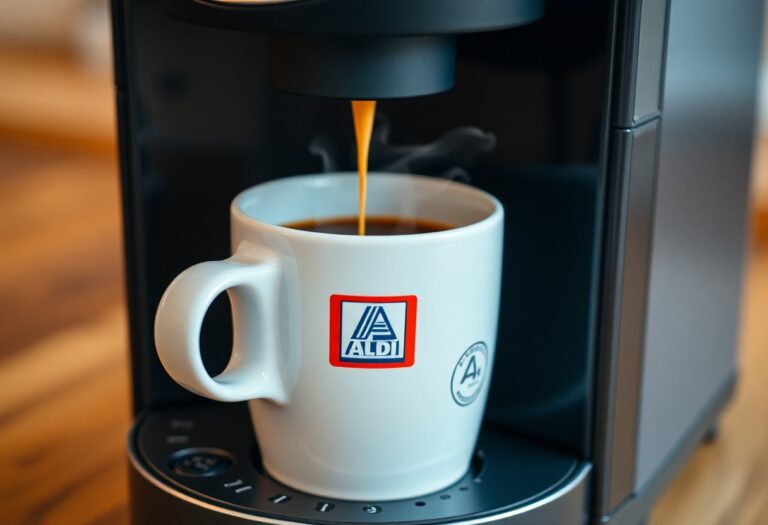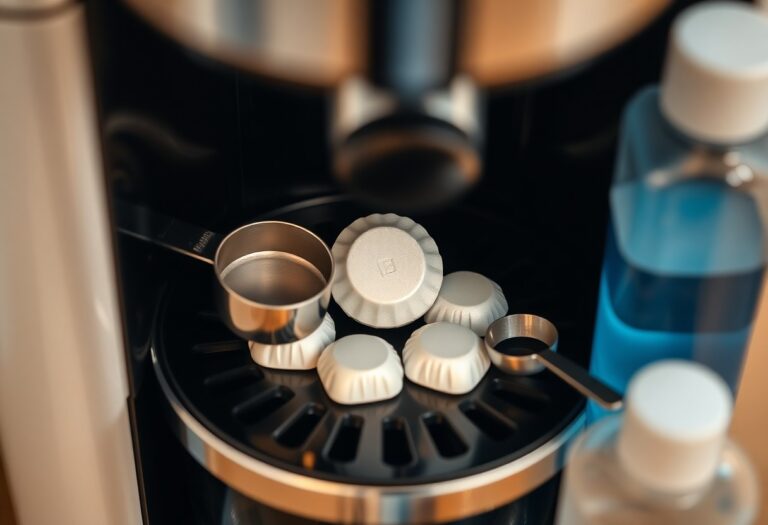What Coffee Machine is Used in Starbucks – Chain Equipment
You might be curious about the type of coffee machine that powers your favorite drinks at Starbucks. The coffee chain relies heavily on high-performance espresso machines, specifically the Nuova Simonelli Aurelia II, renowned for its precision and reliability. This machine not only enhances flavor extraction but ensures that every cup is consistent, catering to your coffee cravings day after day. Understanding the equipment behind your drink can give you a deeper appreciation of the craftsmanship that goes into each brew.
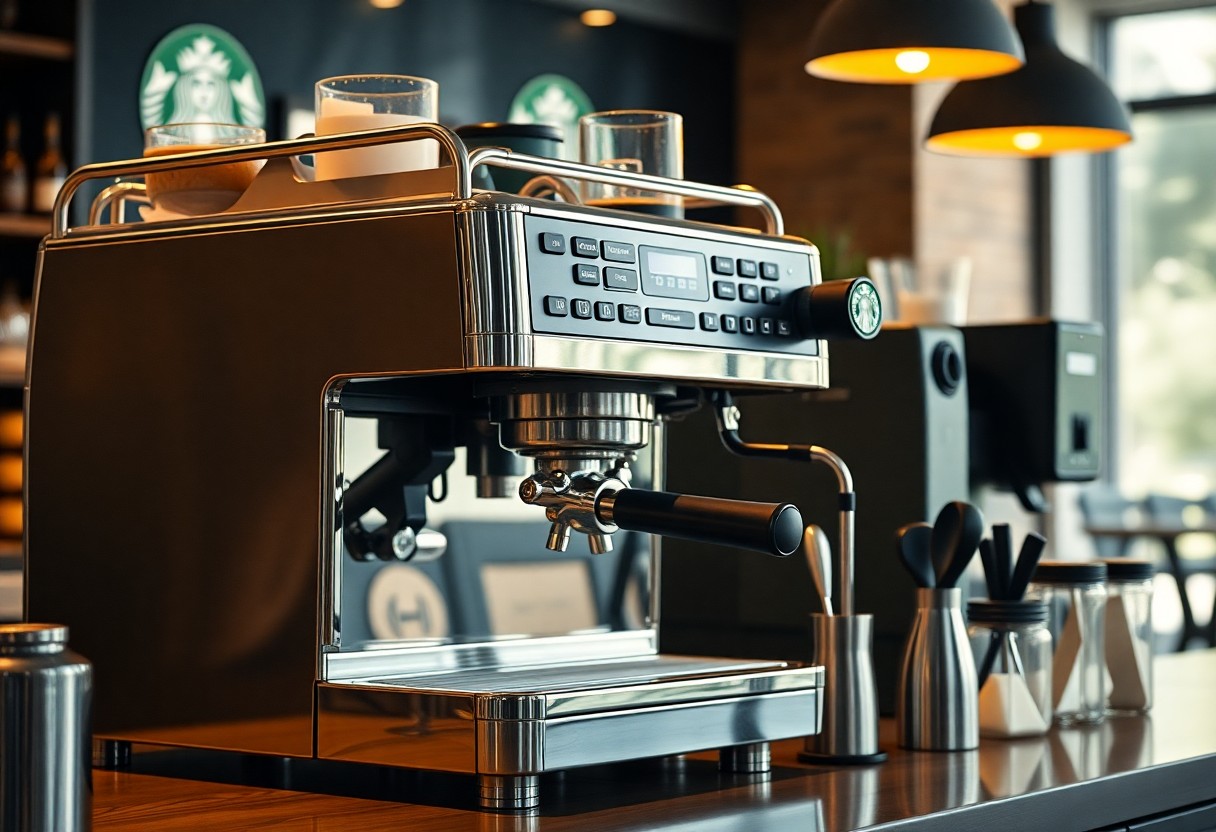
Key Takeaways:
- Starbucks primarily uses the Mastrena espresso machine, designed specifically for their needs.
- The Mastrena offers features such as automatic dosing and programmable options for consistency in drink preparation.
- Starbucks invests in high-quality equipment to enhance the efficiency and speed of service in their stores.
- Alongside espresso machines, Starbucks also employs other equipment like grinders and brewers to create a diverse coffee menu.
- The company regularly updates its equipment to incorporate the latest technology and meet customer demands effectively.
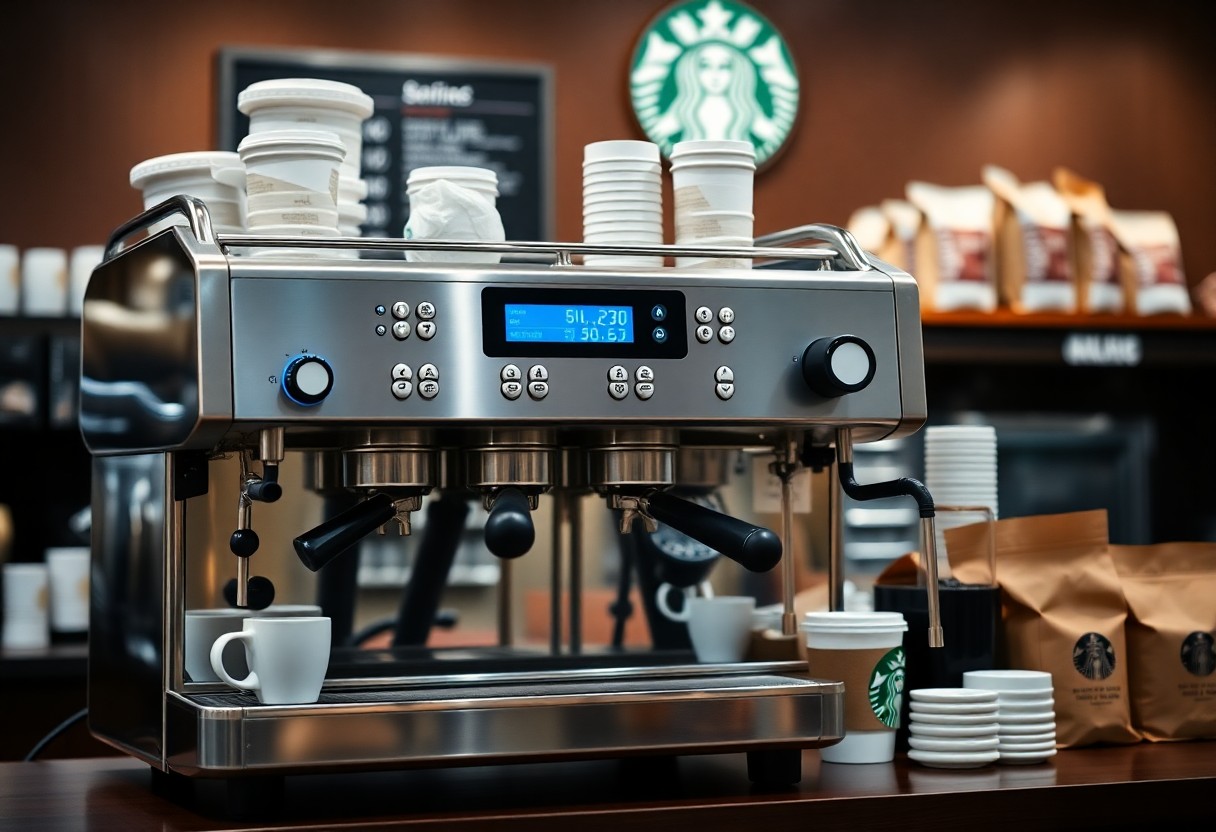
The Indispensable Workhorse: Espresso Machines at Starbucks
The espresso machines at Starbucks serve as the backbone of its beverage offerings, transforming simple ingredients into delightful drinks. These machines not only produce the signature rich espresso shots that form the base of many beverages but also contribute to the consistency and quality that customers expect. If you ever wonder why Costa or Starbucks lattes are so good?, it’s largely due to the precision of these machines.
The Significance of Espresso in Starbucks’ Menu
Espresso plays a vital role in Starbucks’ menu, serving as the foundation for popular drinks like lattes, cappuccinos, and macchiatos. Each shot of espresso offers intense flavors and aromas that elevate your coffee experience. This emphasis on quality espresso helps build customer loyalty and satisfaction, necessary for any successful coffee chain.
Key Features of the Machines Used
Starbucks uses the Mastrena espresso machine, recognized for its innovative technology and exceptional performance. With advanced automation, it helps baristas deliver consistent and high-quality espresso shots with ease. Key features include:
- Integrated grinder: Ensures fresh grounds for each shot.
- Temperature control: Maintains optimal extraction conditions.
- Automated brewing: Simplifies the espresso-making process.
- Customizable settings: Allows adjustments based on drink preferences.
- High-capacity: Designed to handle peak hours efficiently.
Knowing that each machine is tailored to Starbucks’ specifications enables you to appreciate the high standards upheld by the company.
The Mastrena’s design not only maximizes efficiency but also focuses on user-friendliness for baristas, allowing them to serve up to 240 servings per hour during busy shifts. Each feature, from the programmable brewing options to the built-in cleaning systems, is intended to uphold Starbucks’ quality promise while optimizing workflow. Knowing this allows you to truly savor every sip of your favorite coffee concoction, as quality is at the forefront of every cup served.
The Science of Brewing: Standardizing Quality Across Locations
The meticulous science behind brewing at Starbucks guarantees that every cup you enjoy is made to perfection, no matter which location you visit. Standardized brewing methods and detailed guidelines dictate everything from water temperature to grind size, ensuring a consistent flavor profile that Starbucks customers recognize and love. This approach not only strengthens brand identity but also builds customer trust, as you can rely on a familiar taste every time.
How Starbucks Ensures Consistency in Taste
Starbucks employs rigorous training programs and comprehensive quality control measures to maintain consistency in taste across all its locations. Every barista undergoes extensive training on the coffee preparation process, learning how to use equipment correctly and follow standardized recipes. Implementing periodic taste tests and using quality assessments ensures that every cup is up to the brand’s high standards.
The Role of Technology in Brewing
Technology plays an integral role in Starbucks’ brewing processes, allowing for precision and efficiency that elevate your coffee experience. From the advanced Mastrena espresso machines that ensure extraction accuracy to digital scales measuring coffee grounds, every piece of equipment is designed with the goal of optimizing flavor while minimizing human error. This attention to technological details contributes significantly to the overall consistency and quality of the coffee served.
The Mastrena espresso machines are equipped with advanced features, such as programmable recipes and automated cleaning systems, which help regenerate the same delightful taste time and again. Furthermore, Starbucks employs sophisticated monitoring systems to oversee brewing parameters remotely, enabling quick adjustments as needed. By integrating technology into the brewing process, Starbucks not only enhances operational efficiency but also delivers an extraordinary coffee experience tailored to satisfy the evolving tastes and preferences of its customers.
Customization and Innovation: The Machines Behind the Counter
Starbucks embraces customization, allowing customers to personalize their beverages while maintaining high-quality standards. The machines used at Starbucks play a significant role in this process, ensuring every cup meets your taste preferences. With advanced technology, these machines bring consistency and adaptability to every drink, whether you’re ordering a classic espresso or a specialty cold brew. Each piece of equipment, from grinders to brewers, is designed to support a diverse range of customization options, making your coffee experience uniquely yours.
User-Friendly Features for Baristas
Baristas at Starbucks benefit from user-friendly machines that streamline the preparation process. Features such as intuitive touchscreen interfaces and automated milk frothing systems allow you to craft intricate drink orders quickly and efficiently. This ease of use not only minimizes training time but also enhances overall customer satisfaction, as baristas can focus more on artistry and less on operation.
Latest Innovations in Coffee Technology
The world of coffee technology is constantly evolving, and Starbucks is at the forefront of these advancements. Recent innovations include sustainable brewing methods and digital connectivity, ensuring that every cup is made with care for both quality and the environment. These technologies allow for precise temperature control, pressure adjustments, and recipe sharing, ultimately elevating your coffee experience.
Technological advancements in the coffee industry have introduced machines capable of analyzing coffee bean freshness and optimizing brewing conditions in real-time. For instance, some models are equipped with sensors that monitor extraction times and temperature fluctuations, ensuring that your espresso is brewed to perfection every time. Moreover, machines like the Operated Brew System offer seamless integration with mobile applications, giving you the ability to customize your drink from your smartphone. Such innovations not only enhance flavor profiles but also support Starbucks’ commitment to sustainability and quality, making every sip a delightful experience.
Sustainability in Equipment: Starbucks’ Commitment to Green Practices
Starbucks has made significant strides in sustainability, ensuring that their equipment and practices align with eco-friendly principles. Through ongoing investments in sustainable technology and equipment, Starbucks aims to reduce their environmental impact. They also utilize energy-efficient coffee machines, helping to conserve energy while maintaining quality. To discover more about the reliability of the equipment from a barista’s perspective, check out How reliable are the coffee machines at Starbucks ….
Energy-Efficient Coffee Machines
The coffee machines at Starbucks are designed with energy efficiency in mind, featuring programmable settings that reduce energy use during off-peak hours. This not only lowers operational costs but also minimizes their carbon footprint. By incorporating innovative technology, such as automatic shut-off features and energy-saving modes, these machines meet the rigorous standards set for environmentally responsible equipment.
Waste Reduction and Recycling Initiatives
Starbucks actively pursues waste reduction and recycling initiatives, aiming for a sustainable future by minimizing waste generated in their stores. By implementing composting programs and using recyclable materials in packaging, you can enjoy your coffee knowing that Starbucks is dedicated to reducing landfill contributions.
The waste reduction and recycling initiatives at Starbucks extend beyond just recycling cups. They have partnerships with organizations to ensure that food waste is composted and that recyclables are properly processed. In addition, many stores encourage customers to bring reusable cups, offering discounts as an incentive. This collective effort not only contributes to a greener planet but also illustrates Starbucks’ commitment to sustainability. As you sip your favorite blend, it’s comforting to know that each cup supports a broader mission for environmental responsibility.
The Economics of Equipment Choices: What Determines Starbucks’ Investment?
Starbucks’ investment in coffee machine technology is a reflection of its commitment to quality and customer satisfaction. A combination of operational efficiency, brand image, and customer experience drives these choices. Selecting high-end equipment can be costly, but the payoff comes in the form of improved beverage consistency, reduced downtime, and the ability to innovate with new drink recipes. Ultimately, this strategic investment aligns with Starbucks’ branding as a premium coffee provider while ensuring customer loyalty and repeat business.
Cost-Benefit Analysis of High-End Machines
Investing in high-end coffee machines may have a higher upfront cost, yet the benefits often outweigh these expenses. You’ll find that top-tier machines can yield superior extraction results, reduce the need for frequent repairs, and enable higher throughput during peak hours of traffic. This means more satisfied customers and enhanced service speed, translating into higher sales and profitability over time.
The Impact on Overall Customer Experience
The choice of coffee machines significantly influences your experience at Starbucks. You expect every cup of coffee to be expertly brewed, and equipment plays a vital role in ensuring that consistency. High-end machines lead to improved temperature control and precision in brewing, which enhances flavor extraction and aroma. Consequently, each sip you take reflects a carefully crafted beverage, elevating your overall coffee shop visit. Starbucks understands this connection, consistently prioritizing equipment choices that uphold its reputation while providing you with the quality you deserve.
Furthermore, the latest coffee machines often come equipped with features such as programmable settings and advanced diagnostics, allowing baristas to refine their skills and produce beverages tailored to your preferences. Training staff on these machines ensures they can utilize the full capabilities of the equipment, resulting in quicker service and personalized drinks. This level of care and attention to detail not only enhances your coffee experience but also fosters a connection between you and the Starbucks brand. Each visit becomes a moment to savor, knowing you’re getting a consistently high-quality product that fits perfectly into your busy lifestyle.
To wrap up
Taking this into account, understanding the specific coffee machines used in Starbucks helps you appreciate the brand’s commitment to quality and consistency in every cup. Their choice of machines, such as the signature Mastrena, showcases advanced technology designed to enhance your coffee experience. By knowing these details, you can better replicate that café-style flavor at home or when exploring similar options. Embracing these insights empowers you in your coffee journey, ensuring that each brew meets your expectations for taste and satisfaction.
FAQ
Q: What type of coffee machines are commonly used in Starbucks locations?
A: Starbucks primarily uses espresso machines from the brand La Marzocco, especially their Strada and Linea models. These machines are known for their reliability, consistency, and ability to produce high-quality espresso shots, which is imperative for their specialty coffee drinks.
Q: Why does Starbucks choose La Marzocco for their espresso machines?
A: Starbucks selects La Marzocco for their espresso machines due to the brand’s reputation for quality craftsmanship and innovative technology. The machines offer precise temperature control and are designed for high-volume use, making them suitable for the busy environment of a Starbucks outlet.
Q: How often do Starbucks locations maintain their coffee machines?
A: Maintenance is a priority for Starbucks, and their coffee machines undergo regular cleaning and maintenance schedules. Technicians perform routine checks, clean the machines, and calibrate them to ensure that they are always producing the best possible coffee quality.
Q: What features do Starbucks coffee machines have that enhance the coffee-making process?
A: The coffee machines used in Starbucks, particularly the La Marzocco models, come with advanced features such as dual boilers, rotary pumps, and PID temperature control. These features help regulate water temperature and pressure, delivering consistent espresso extraction, which is vital for crafting their signature drinks.
Q: Can customers purchase the same coffee machines used in Starbucks for home use?
A: While Starbucks does not sell the exact same commercial machines used in-store, customers can purchase home versions of La Marzocco machines designed for residential use. These home machines are designed to replicate the café experience but are typically less complex and lower in cost compared to commercial models.

